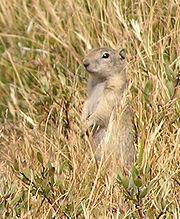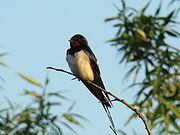
Alarm call
Encyclopedia

Animal communication
Animal communication is any behavior on the part of one animal that has an effect on the current or future behaviour of another animal. The study of animal communication, is sometimes called Zoosemiotics has played an important part in the...
, an alarm signal is an antipredator adaptation referring to various signal
Signalling theory
Within evolutionary biology, signalling theory is a body of theoretical work examining communication between individuals. The central question is when organisms with conflicting interests should be expected to communicate "honestly"...
s emitted by social animal
Animal
Animals are a major group of multicellular, eukaryotic organisms of the kingdom Animalia or Metazoa. Their body plan eventually becomes fixed as they develop, although some undergo a process of metamorphosis later on in their life. Most animals are motile, meaning they can move spontaneously and...
s in response to danger. Many primates and birds have elaborate alarm calls for warning conspecifics
Conspecificity
Conspecificity is a concept in biology. Two or more individual organisms, populations, or taxa are conspecific if they belong to the same species....
of approaching predators. For example, the characteristic alarm call of the Blackbird is a familiar sound in many gardens. Other animals like fish and insects may use other non-auditory signals, such as chemical messages. While visual signs have been suggested as alarm signals, they are easier to pinpoint by predators and less likely to be received by conspecifics, so have tended to be treated as a signal to the predator instead.
Different calls may be used for predators on the ground or from the air. Often, the animals can tell which member of the group is making the call, so that they can disregard those of little reliability.
Evidently, alarm signals promote survival by allowing the receivers of the alarm to escape from the source of peril, but this ecological safety system may come at a cost to the signaller. When an animal calls attention to itself by signalling, it may be more likely to be eaten by a predator than if it had kept quiet. This intuition has been verified by experimental data on ground squirrel predation rates and the connection between this and the noisy chirping or whistling alarm calls. However, there is also some evidence that alarm calls can increase individual fitness as well.
Alarm calls are often high frequency sounds because these sounds are harder to localize, despite common belief.
Selective advantage
This cost/benefit tradeoff of alarm calling behaviour has sparked many interest debates among evolutionary biologists seeking to explain the occurrence of such apparently "self-sacrificing" behaviour. The central question is this: "If the ultimate purpose of any animal behaviour is to maximize the chances that an organism's own genes are passed on, with maximum fruitfulness, to future generations, why would an individual deliberately risk destroying themselves (their entire genome) for the sake of saving others (other genomes)?".Some scientists have used the evidence of alarm-calling behaviour to challenge the theory that "evolution works only/primarily at the level of the gene
Gene
A gene is a molecular unit of heredity of a living organism. It is a name given to some stretches of DNA and RNA that code for a type of protein or for an RNA chain that has a function in the organism. Living beings depend on genes, as they specify all proteins and functional RNA chains...
and of the gene's "interest" in passing itself along to future generations." If alarm-calling is truly an example of altruism
Altruism
Altruism is a concern for the welfare of others. It is a traditional virtue in many cultures, and a core aspect of various religious traditions, though the concept of 'others' toward whom concern should be directed can vary among cultures and religions. Altruism is the opposite of...
, then our understanding of natural selection becomes more complicated than simply "survival of the fittest gene".
Other researchers, generally those who support the selfish gene theory, question the authenticity of this "altruistic" behaviour. For instance, it has been observed that Vervets sometimes emit calls in the presence of a predator, and sometimes do not. Studies show that these Vervets may call more often when they are surrounded by their own offspring and by other relatives who share many of their genes. Other researchers have shown that some forms of alarm calling, for example, "aerial predator whistles" produced by Belding's Ground Squirrel
Belding's Ground Squirrel
Belding's ground squirrel , also called pot gut, sage rat or picket-pin, is a squirrel that lives on mountains in the western United States. In California, it often is found at 6,500–11,800 feet in meadows between Lake Tahoe and Kings Canyon...
s, do not increase the chances that a caller will get eaten by a predator; the alarm call is advantageous to both caller and recipient by frightening and warding off the predator.
Another theory suggests that alarm signals function to attract further predators, which fight over the prey organism, giving it a better chance of escape. Others still suggest they are a deterrent to predators, communicating the animals alertness to the predator. One such case is the Eastern Swamphen (Porphyrio porphyrio), which gives conspicuous visual tail flicks (see also aposematism
Aposematism
Aposematism , perhaps most commonly known in the context of warning colouration, describes a family of antipredator adaptations where a warning signal is associated with the unprofitability of a prey item to potential predators...
, handicap principle
Handicap principle
The handicap principle is a hypothesis originally proposed in 1975 by biologist Amotz Zahavi to explain how evolution may lead to "honest" or reliable signaling between animals who have an obvious motivation to bluff or deceive each other...
and stotting
Stotting
Stotting is a gait of quadrupeds, particularly gazelles , involving jumping high into the air by lifting all four feet off the ground simultaneously. This may occur during pursuit by a predator...
).
Considerable research effort continues to be directed toward the purpose and ramifications of alarm-calling behaviour, because, to the extent that this research has the ability to comment on the occurrence or non-occurrence of altruistic behaviour, we can apply these findings to our understanding of altruism in human behaviour.
Monkeys with alarm calls

Dar es Salaam
Dar es Salaam , formerly Mzizima, is the largest city in Tanzania. It is also the country's richest city and a regionally important economic centre. Dar es Salaam is actually an administrative province within Tanzania, and consists of three local government areas or administrative districts: ...
.]]
Vervet monkey
Vervet Monkey
The vervet monkey , or simply vervet, is an Old World monkey of the family Cercopithecidae native to Africa. The term "vervet" is also used to refer to all the members of the genus Chlorocebus....
s are the typical example of both animal alarm calls and of semantic capacity in non-human animals. They have three distinct calls for leopards, snakes, and eagles
Eagles
The Eagles are an American rock band formed in Los Angeles, California in 1971 by Glenn Frey, Don Henley, Bernie Leadon, and Randy Meisner.With five number one singles, six Grammys, five American Music Awards, and six number one albums, the Eagles were one of the most successful musical acts of the...
, and research shows that each call elicits different responses. When vervets are on the ground they respond to the eagle alarm call by looking up and running to cover, to leopard alarm calls primarily by looking up and running into a tree, and to the snake alarm call primarily by looking down. When in trees vervets responded to the eagle alarm call by looking up and down and running out of trees, to the leopard alarm call by running higher in the tree and looking both up and down, and to the snake alarm call by looking primarily down.
Campbell's mona monkey
Campbell's Mona Monkey
Campbell's mona monkey , also known as Campbell's guenon and Campbell's monkey, is a species of primate in the Cercopithecidae family...
s also generate alarm calls, but in a different way than Vervet monkeys. Instead of having discrete calls for each predator, Campbell Monkeys have two distinct types of calls which contain different calls which consist in an acoustic continuum of affixes which change meaning. It has been suggested that this is a homology
Homology
Homology may refer to:* Homology , analogy between human beliefs, practices or artifacts owing to genetic or historical connections* Homology , any characteristic of biological organisms that is derived from a common ancestor....
to human morphology
Morphology (linguistics)
In linguistics, morphology is the identification, analysis and description, in a language, of the structure of morphemes and other linguistic units, such as words, affixes, parts of speech, intonation/stress, or implied context...
. Campbell Monkeys also demonstrated abilities similar to Vervet Monkeys' ability to distinguish likely direction of predation and appropriate responses.
That these two species
Species
In biology, a species is one of the basic units of biological classification and a taxonomic rank. A species is often defined as a group of organisms capable of interbreeding and producing fertile offspring. While in many cases this definition is adequate, more precise or differing measures are...
use vocalizations to warn others of danger has been called by some proof of protolanguage in primates. However, there is some evidence that this behavior does not refer to the predators themselves but to threat, distinguishing calls from words.
False alarm calls

Deception
Deception, beguilement, deceit, bluff, mystification, bad faith, and subterfuge are acts to propagate beliefs that are not true, or not the whole truth . Deception can involve dissimulation, propaganda, and sleight of hand. It can employ distraction, camouflage or concealment...
alarm calls are used by male swallows (Hirundo rustica). Males give these false alarm calls when females leave the nest area during the mating
Mating
In biology, mating is the pairing of opposite-sex or hermaphroditic organisms for copulation. In social animals, it also includes the raising of their offspring. Copulation is the union of the sex organs of two sexually reproducing animals for insemination and subsequent internal fertilization...
season, and are thus able to disrupt extra-pair copulations. As this is likely to be costly to females, it can be seen as an example of sexual conflict
Sexual conflict
Sexual conflict occurs when the two sexes have conflicting optimal fitness strategies concerning reproduction, particularly the mode and frequency of mating, leading to an evolutionary arms race between males and females. The conflict encompasses the actions and behaviors of both sexes to influence...
.
Counterfeit alarm calls are also used by thrushes
Thrush (bird)
The thrushes, family Turdidae, are a group of passerine birds that occur worldwide.-Characteristics:Thrushes are plump, soft-plumaged, small to medium-sized birds, inhabiting wooded areas, and often feed on the ground or eat small fruit. The smallest thrush may be the Forest Rock-thrush, at and...
to avoid intraspecific competition
Intraspecific competition
Intraspecific competition is a particular form of competition in which members of the same species vie for the same resource in an ecosystem...
. By sounding a bogus alarm call normally used to warn of aerial predators, they can frighten other birds away, allowing them to eat undisturbed.
Vervets seem to be able to understand the referent of alarm calls instead of merely the acoustic properties, and if another species' specific alarm call (terrestrial or aerial predator, for instance) is used incorrectly with too high of a regularity, the vervet will learn to ignore the analogous vervet call as well.
Alarm pheromones
Alarm signals need not be communicated only by auditoryHearing (sense)
Hearing is the ability to perceive sound by detecting vibrations through an organ such as the ear. It is one of the traditional five senses...
means. For example, many animals may use chemosensory alarm signals, communicated by chemicals known as pheromone
Pheromone
A pheromone is a secreted or excreted chemical factor that triggers a social response in members of the same species. Pheromones are chemicals capable of acting outside the body of the secreting individual to impact the behavior of the receiving individual...
s. Minnows and catfish release alarm pheromones (Schreckstoff
Schreckstoff
In 1938, the Austrian ethologist Karl von Frisch made his first report on the existence of the chemical alarm signal known as Schreckstoff in minnows. An alarm signal is a response produced by an individual, the “sender,” reacting to a hazard that warns other animals, the receivers, that there is...
) when injured, which cause nearby fish to hide in dense schools near the bottom. Animals are not the only organism to communicate threats to conspecifics either; some plants are able to perform a similar trick. Lima bean
Lima bean
Phaseolus lunatus is a legume. It is grown for its seed, which is eaten as a vegetable. It is commonly known as the lima bean or butter bean.-Origin and uses:...
s release volatile
Volatility (chemistry)
In chemistry and physics, volatility is the tendency of a substance to vaporize. Volatility is directly related to a substance's vapor pressure. At a given temperature, a substance with higher vapor pressure vaporizes more readily than a substance with a lower vapor pressure.The term is primarily...
chemical signals that are received by nearby plants of the same species when infested with spider mite
Spider mite
Spider mites are members of the Acari family Tetranychidae, which includes about 1,200 species. They generally live on the under sides of leaves of plants, where they may spin protective silk webs, and they can cause damage by puncturing the plant cells to feed...
s. This 'message' allows the recipients to prepare themselves by activating defense genes, making them less vulnerable to attack, and also attracting another mite species that is a predator of spider mites (indirect defence). Although it is conceivable that other plants are only intercepting a message primarily functioning to attract "bodyguards", some plants spread this signal on to others themselves, suggesting an indirect benefit from increased inclusive fitness
Inclusive fitness
In evolutionary biology and evolutionary psychology, the inclusive fitness of an organism is the sum of its classical fitness and the number of equivalents of its own offspring it can add to the population by supporting others...
.
False chemical alarm signals are also employed. The aphid Myzus persicae
Myzus persicae
Myzus persicae, known as the green peach aphid, is a small green aphid. It is the most significant aphid pest of peach trees, causing decreased growth, shriveling of the leaves and the death of various tissues...
is repelled by the wild potato
Wild potato
Wild potato may refer to:* Several species belonging to the genus Solanum, such as Solanum jamesii, Solanum berthaultii, etc.* Thladiantha dubia...
Solatium berthaultii which releases a chemical from its leaves that acts as an allomone
Allomone
An allomone is any chemical substance produced and released by an individual of one species that affects the behaviour of a member of another species to the benefit of the originator but not the receiver...
to disrupt aphid attacks.
External links
- Chickadees' alarm-call carry information about size, threat of predator
- The Trek of the Pika "A story complete with sounds of pika and marmot calls" 2002-10-30
- Characteristics of arctic ground squirrel alarm calls OecologiaOecologiaOecologia is an international peer-reviewed English-language journal published by Springer. The journal publishes original research in a range of topics related to plant and animal ecology....
Volume 7, Number 2 / June, 1971 - Why do Yellow-bellied Marmots Call? Daniel T. Blumstein & Kenneth B. Armitage
Department of Systematics and Ecology, University of Kansas

